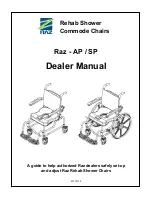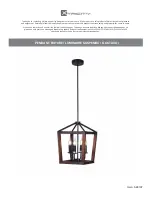
3
Raz-AP/SP Dealer Manual
20170110
USERS MUST NOT
position the Raz Shower Chair on a side slope
as this could cause it to tip.
Rearward Stability
USERS MUST NOT
wheel up an incline on a SP Model without
ensuring that the optional rear anti-tippers are in place. The optional
anti-tippers must be ordered with the Raz SP and properly installed
before wheeling on uneven surfaces.
Anti-Tippers - SP Model
Anti-tippers are an option for the Raz SP Shower Chairs. These are
recommended whenever the chairs are to be used on uneven
surfaces such as ramps or sloped floors, when used by lower-limb
amputees, when the rear wheels are moved forward from the
factory-set position or for any situations when rearward stability is
compromised.
Ramps and Other Inclines
Ramps and other surfaces that are not level (such as slopes into
wheel-in showers) must be tested with an attendant to ensure
that they don
’t compromise the chair’s stability. A qualified
healthcare professional should be consulted to assist with this
process.
DO NOT push or pull the Raz AP up or down an incline or ramp
that exceeds a 1:12 grade (5° slope)
.
DO NOT
allow any user to be propelled (pushed or pulled) in a
Raz-AP Shower Chair in any other manner than by an attendant.
IMPORTANT !
THE REARWARD STABILITY OF THE RAZ SP IS AFFECTED BY THE MOUNTING LOCATION
OF THE REAR WHEELS, THE PHYSICAL AND CLINICAL CHARACTERISTICS OF THE USER
AND THE ANGLE OF THE BACKREST. THE NEED FOR ANTI-TIPPERS SHOULD HAVE BEEN
DETERMINED AT THE TIME OF THE PRESCRIPTION OF THE RAZ SP WITH
CONSIDERATION OF THE USER
’S PHYSICAL ATTRIBUTES AND ENVIRONMENT. ANTI-
TIPPERS MAY BE ORDERED AS A RETROFIT AT ANY TIME IF IT IS DETERMINED THAT THEY
ARE REQUIRED.
Immersion
The Raz Shower Chair is not designed to be used as a pool chair. Do
not immerse the shower chair in whole or in part, in water or any other
liquid. Damage to the shower chair components may result.
Transfers
The most dangerous part of using any shower chair is the transfer. Since every chair has different
stability characteristics, it is essential to carefully review and test the transfer technique to ensure
that the procedure is safe. Test transfers should be performed with an attendant who can prevent
the chair from tipping or moving during the transfer. If you feel that the transfers cannot be
repeatedly performed safely, contact a healthcare professional who is familiar with transfer
techniques and options. Individuals who have not learned safe transfer skills must seek assistance
during transfers and may require the use of a mechanical lift.

































